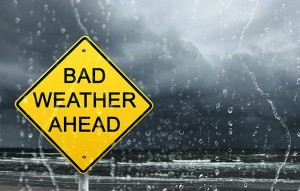Driving in All Types of Weather

Some accidents are nearly unavoidable, but driving in unsafe road conditions greatly increases your risk of getting in an accident and damaging your vehicle. If you are going to be driving in unsafe conditions, make sure that you are prepared and know how to handle them. Although we’d love your business, safety is our first priority. To put safety first and avoid a collision, here are our Xpert tips when driving in dangerous road conditions:
Rain
Rain can be the most dangerous driving condition. Vision is impaired, roads are slick, and other drivers are probably behaving unexpectedly. It’s a good idea to replace your windshield wipers every six months to a year to make sure that they are functioning properly so you can maintain vision even in inclement weather. When the roads are wet, it takes longer for your car to adjust; you should drive slower than in clear conditions so that you can steer and brake properly.
Flooding
Water usually collects on the sides of the road, so you should drive in center lanes to reduce the risk of hydroplaning. Never enter a section of road where the water is too deep to see the ground through, as this can cause severe damage to the electrical system in your car. You should try to drive in tracks left by the cars in front of you, as these areas have better traction. Don’t follow anyone, especially large vehicles, too closely as their tires can spray water onto your windshield and make it impossible for you to see.
Snow
Snow poses many threats similar to those created by rain. The most important thing to remember is that you need to make sure that you can see traffic and others can see you. It is a good idea to keep your lights on, even in the daytime, to make sure others can see you. You should leave plenty of space between you and the vehicle in front of you; a good estimate is about three times as much space as you would normally leave. Snow on the road creates low traction for your tires and makes it more difficult to slow and stop your car. Apply your brakes slowly to prevent skidding.
Ice
Ice often accompanies snow and it poses a serious threat, as it can be very difficult to see. In the winter months you should be especially cautious on overpasses, bridges, and roads that are not used frequently, as these are the first areas that will freeze over. However, ice may form anywhere in wet conditions, even when temperatures are above freezing; shady and windy areas may still be cold enough to create ice. Never pass sanding trucks or snow plows, as it is very likely that the road ahead is not safe to drive on.
Fog
If you are driving in fog, make sure that you turn off your high beams, as these will reflect on the fog and make it impossible to see. Instead, use your fog lights. Since visibility is reduced, it is a good idea to make use of noises by turning off the radio and opening the windows; this way you can listen for braking vehicles or motorists coming up behind you. As in any dangerous road condition, you should drive slowly and cautiously. It is a good idea to drive in the right-most lane so that you do not risk driving into oncoming traffic.
High Winds
Be prepared to account for the extra force being applied to your vehicle when driving in high wind conditions. You will have to over correct when steering to compensate for the directional force of the wind depending on which way it is forcing your vehicle. The faster you are going, the more the wind will affect your vehicle. You should avoid driving next to other vehicles, especially large trucks or SUVs, as a sudden wind could force them to swing out and hit you.
Of course, the safest way to handle unsafe road conditions is to stay off the road if you can. If you must drive, stay calm and drive safely by following these Xpert tips.
